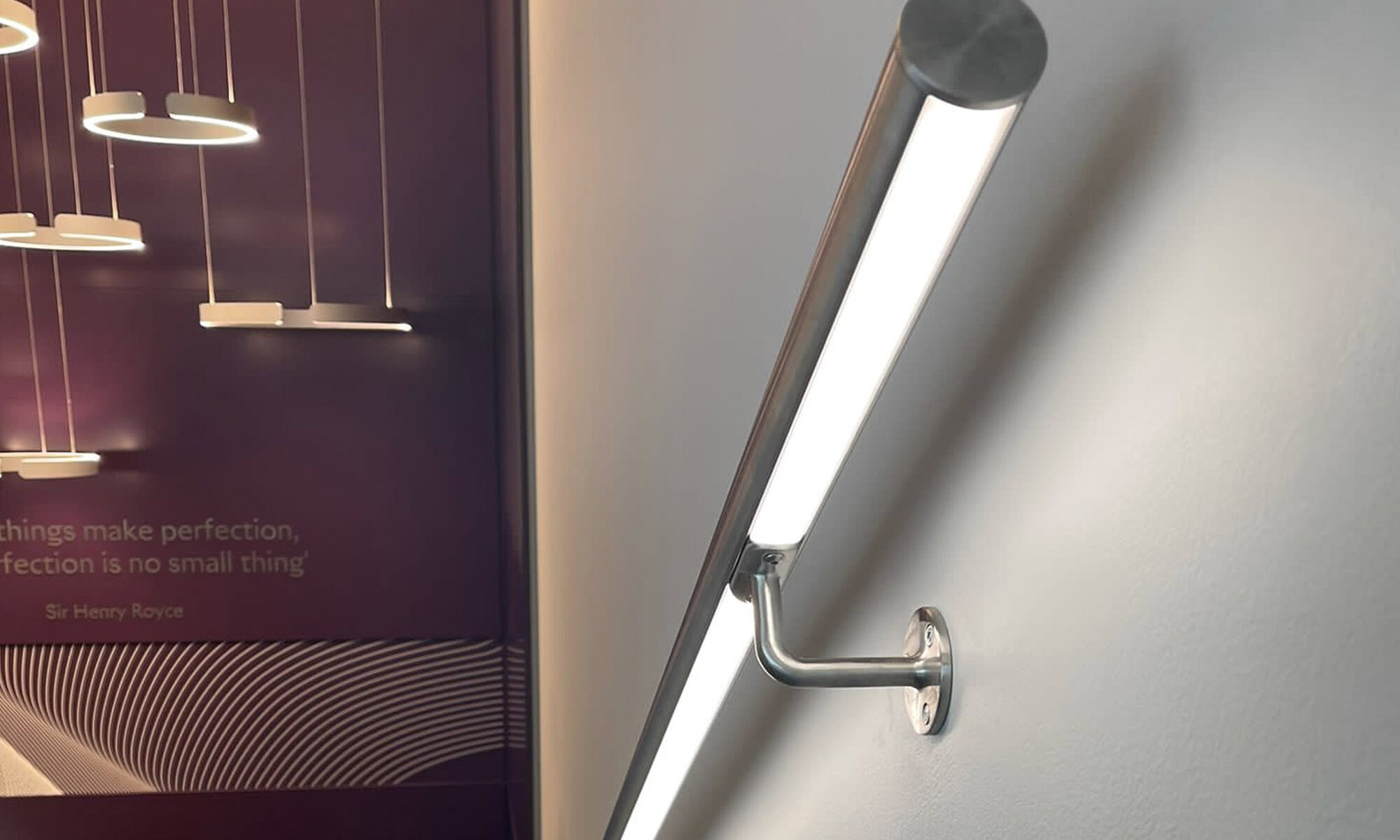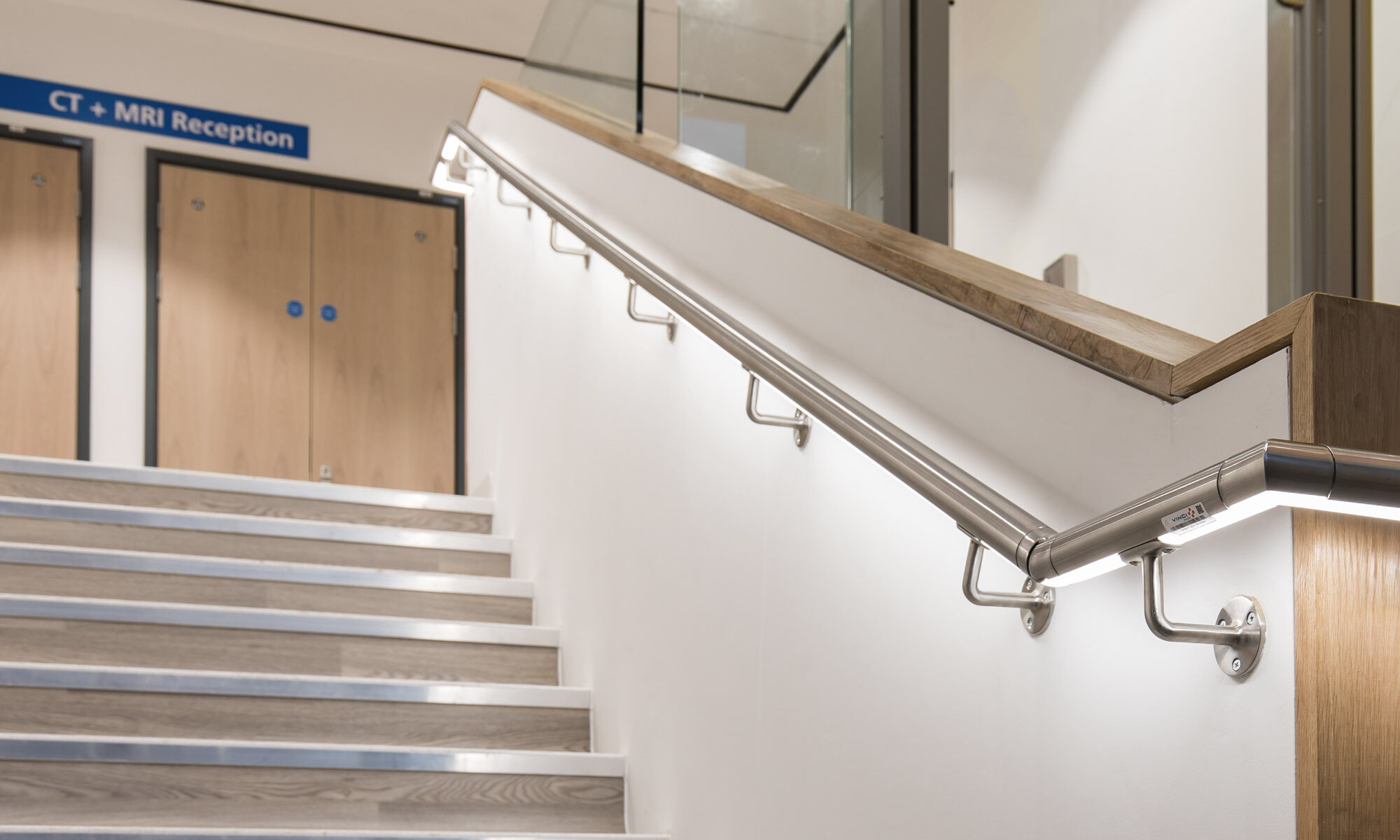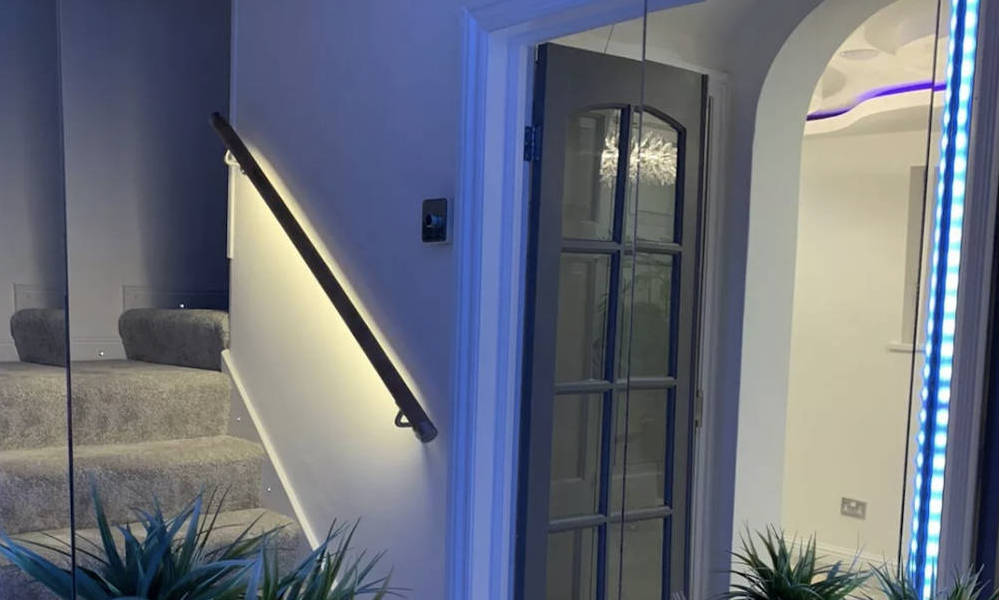TT Solutions and Interiors Ltd, Oxfordshire
Warner Hotels, Heythrop Park
LED Handrails supplied and installed a total of 11 metres of our premium solid oak handrail. The handrails were stained to match the client’s precise colour requirements, and the included accessories were hand-picked and finished to fit seamlessly with the hotel’s visual identity.
Client
TT Solutions and Interiors Ltd
Our Solution
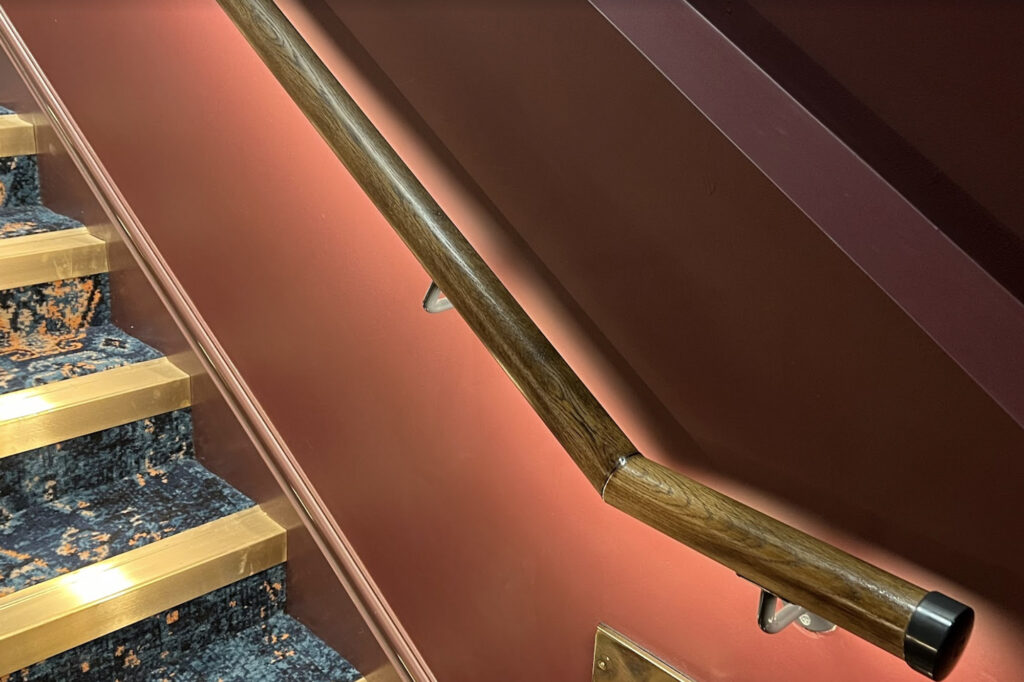

‘’Like going out to see a show, the experience is all about relaxing (maybe with popcorn and a G&T from the box office) as the magic unfolds on stage. Perfect lighting for Musicals, bands and cinema experiences. This is the place to forget inhibitions, command the dance floor and feel the energy of live music’’
UNTIL Liverpool Street, London
UNTIL Liverpool Street, London
LED Handrails supplied and installed a total of 25 metres of stainless-steel LED handrail in the main entrance of a state-of-the-art, ultra-modern fitness and wellbeing centre. The gym is located in the basement of the newly refurbished DUO Spitalfields — a prestigious and high-traffic location.
Client
IOR
Our Solution

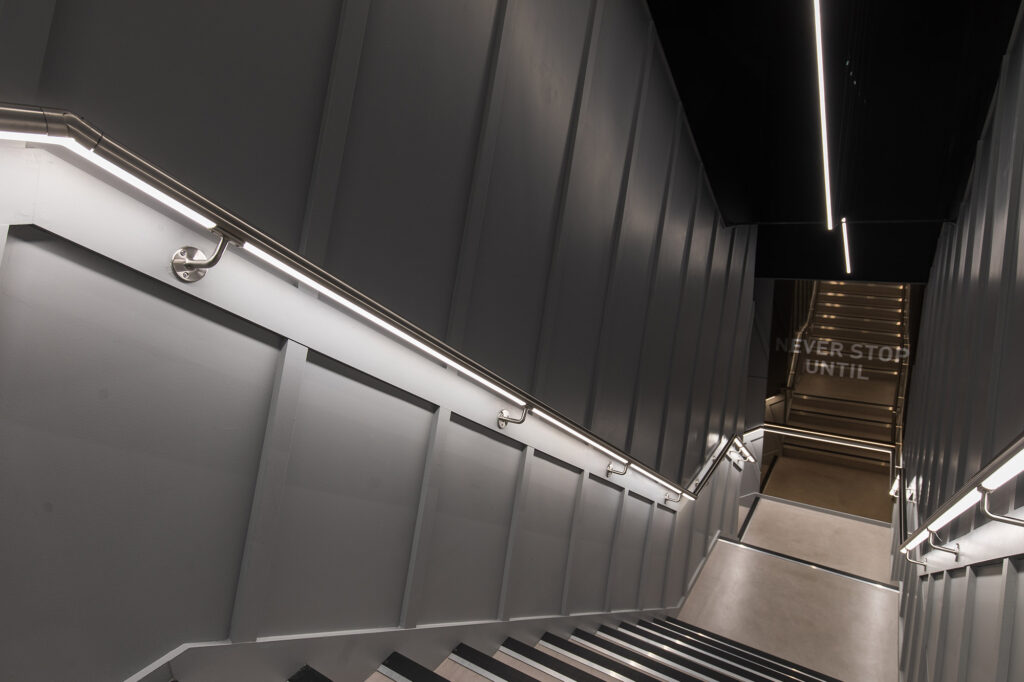


Queen Elizabeth Hospital, London
Queen Elizabeth Hospital, London
LED Handrails supplied and installed a total of 20 meters of our stainless-steel handrails to provide low-profile yet effective lighting to the entrance area of the newly refurbished MIR department at the hospital.
Client
Rosguill Developments Limited
Our Solution




“LED-Handrails has provided the hospital with the perfect ambient lighting system to greet all our patients here in the new MIR department. They are of very high quality and look fantastic!’’
How to ensure your staircase handrail installation is the correct height
Beautiful, elegant steel or wood handrails can provide an impressive finish to stairs, landings and hallways. But there is more to consider than just the aesthetics, with several legal requirements to be aware of when installing a new handrail on your staircase.
In the UK, there are strict guidelines in place to ensure every handrail meets safety regulations. Reputable construction workers should know the building regulations inside and out, but if you’re completing a home renovation project yourself, you’ll need to understand the relevant rules before you make a start.
In this article, we’ve outlined the key things you need to know about safe and compliant staircase handrail installation.
Staircase handrail installation: Safety regulations overview
It is a legal requirement in UK homes to have at least one handrail installed on a staircase. In some cases, you’ll need to install two. This depends on the width of the stairs, with a width of less than 1000mm requiring you have one handrail fitted and anything above this width requiring a second.
If a change in direction splits your staircase – for example, with a bullnose staircase – any part with two steps or less is exempt from requiring hand support. Your handrail needs to start wherever a flight of three steps or more begins.
The legislation forms a part of the Building Regulations 2010, which means any new builds or homes built after the ruling came into effect must comply. If your home was built before 2010 and is undergoing renovation with a handrail already fitted, that handrail may also need to be replaced.
Homes built before 2010 without a handrail are exempt, but it is still important to consider adding one as it will provide a base level of safety for people using your stairs.
Handrail height requirements
To be compliant, handrails must be fitted at a height between 900mm and 1000mm from the pitch line – a virtual line running diagonally between the right-angled area at the edge of each step.
A wall-mounted handrail relies on a bracket at each end to keep it in place. There are no set measurements for the distance between your brackets, although the longer the handrail, the more brackets you will need at intermittent points along the way for adequate support.

A side-note on steps
If your builder is installing a complete staircase with a handrail, they will have already considered the regulations around the steps themselves, which require a consistent height and depth from one to the next. However, if this is a DIY project, you must familiarise yourself with the rules before putting your staircase together.
Sizing regulations for steps in a residential setting differ from those situated in a public space. The following regulations ensure your stairs at home meet the correct measurements for safety:
“The Rise (the vertical section at the back of each step) cannot exceed 220mm in height, while the Going (the horizontal flat area we step onto) must be at least 220mm in depth.”

Your landing handrails
Safety at the top of the stairs is just as crucial as safety on the stairs, particularly where your home has a balcony overlooking a lower area.
As with a staircase, the handrail on a landing balcony has a height requirement of between 900mm and 1000mm to be classed as safe. Start your measurement from the floor upward to ensure the correct height for compliance.
If this is a replacement handrail on a landing that is already carpeted, you should roll back the carpet to uncover the floorboards, then begin measuring from there to assure accuracy.
To understand more about the regulations in the UK for fitting handrails refer to this paper on the Government website.
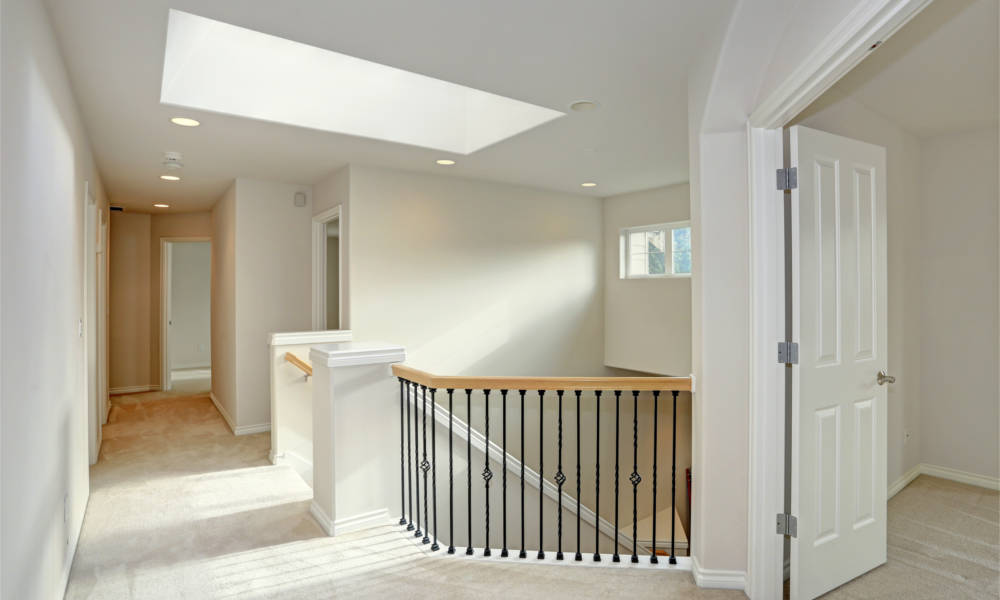
Now you know the rules on handrails, all that’s left to do is choose a style to suit your home. And if you need some inspiration, why not check out our handy guides:
Oak handrail installation ideas for your home refurbishment
Incorporate stainless steel handrails within your next design project
When it comes to handrails, you can trust the experts at LED Handrails. Our products are manufactured in the UK to the highest quality, installed to British Standards and always adhere to building regulations as appropriate.
Contact our team today to discuss your handrail project.
Incorporate Stainless Steel Handrails seamlessly within your next design project
Handrails offer essential support in and around a home or business. And these days, it’s easy to feel spoilt for choice with an endless array of handrail products on offer. Among the most popular is the stainless steel handrail – practical, durable and elegant.
But just because it’s made of metal, don’t assume a chrome colour is your only option here. Nowadays, there are stainless steel options with multiple finishes, styles and shades available, making this an extremely versatile option and a solution that’s customisable to what type of décor you’re looking to match.
Traditional stainless steel handrails
Brushed stainless steel handrails complement any surroundings, whether incorporated within a modern design interior or integrated into a more traditional room.
A polished metal finish looks fantastic when paired with contemporary greys or dark blues. And it works equally well with natural colours – creams, beiges and pastels – to give classic interiors a modern twist.
Powder-coated and coloured stainless steel handrails
Timeless and dependable black or white handrails never go out of style and provide a clean, contemporary look. If you want longevity in terms of aesthetics and durability, black or white is always a safe bet.

Alternatively, how about keeping a metallic finish but giving it a more luxurious feel? A gold coating will give your interior a luxurious, extravagant appearance. Or, if you prefer something more subtle, try copper – effective at bringing spaces to life without being too overpowering.
Perhaps your project needs something a little more vibrant? Here’s the great thing about powder-coated stainless steel – using RAL colour matching, you can go for any colour you like.
Add some LED lighting
For an uber-modern look, how about adding in some lighting? Integrating LEDs into stainless steel handrails is becoming increasingly popular, and when you look at the end product, it’s easy to see why.
Not only do LED handrails look amazing, but they also provide a safety element by giving walkways or staircases added illumination. Our LED handrails have a three-hour failover battery life, keeping exit routes lit even if your main power fails.
And you can choose from cool white, natural white or warm white lighting shades to suit the mood and ambience of the space.
Stainless steel handrails for external use
For external walkways and staircases, stainless steel handrails can be treated to withstand the elements and potential damage from the sun, rain or wind. You get all the same benefits as with your indoor rails, but outside.

And with LED integration, your external handrails will look fantastic day or night, safely lighting the way for your visitors.
Stainless steel handrails for the home
Stainless steel LED handrails are the perfect way to add the finishing touches to your home. The integrated energy-efficient LEDs make it easy to light up your staircase at night without incurring huge energy bills – ideal if you want to keep stairs illuminated to ensure safety through the night.
Stainless steel handrails for commercial use
Our stainless steel handrails are ideal for a range of commercial uses, including:
- Hospitals and care home facilities
- Public bathrooms and toilets
- Educational facilities
- Stadiums and arenas
- Bridges and pedestrian walkways
- Hotels, restaurants and bars
- Cinemas
- Multi-storey car parks
- Museums
- Shopping centres
- Office premises

Why choose stainless steel handrails?
There are many benefits to choosing stainless steel handrails for your home or business.
- Durable
- Low maintenance
- Easy to clean
- Suit any décor
- Range of colour finishes
- Use internally or externally
- Integrated LED lighting
Whatever colour or style of LED stainless steel handrails you choose, they’ll look amazing and add that ‘wow’ factor to your space.
Let’s talk handrails
When it comes to stainless steel handrails, you can trust the experts at LED Handrails. Our products are manufactured to the highest quality, installed to British Standards and always adhere to building regulations as appropriate.
Contact our team today to discuss your handrail project.
Oak handrail installation ideas for your home refurbishment

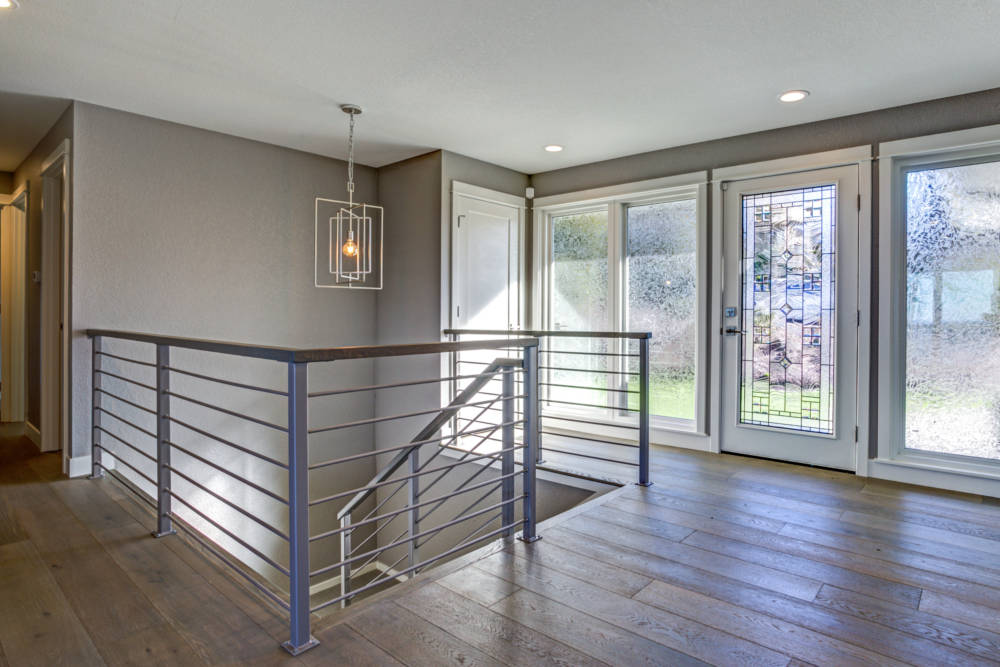
When it comes to providing support for your staircases, exterior walkways or balconies, nothing says quality quite like an oak handrail. Oak handrails complement any décor, whether modern or traditional. And thanks to them being made from a highly durable material, you’ll have peace of mind your oak handrails are a solid investment, lasting for many years to come.
If you’re working with an interior designer on your renovation project, they’ll likely have mentioned oak handrails as the perfect enhancement to your home. But whether yours is a DIY project or one where a designer is providing guidance, ultimately, it’s down to you to make the final choice on the type of handrails to install.
Here are a few tips to help you make this all-important decision and select the best oak handrail for your home.
Where is your oak handrail being used?
The location of your oak handrail and its intended purpose will help you choose the best solution to suit your needs. Will your oak handrail be wall-mounted next to a staircase? Or are you providing the edging for a glass balustrade? Is it being used internally or externally?
Internal: A grooved oak handrail looks stunning when used with glass and provides a real natural yet contemporary vibe to your home. Perfect where balustrades line the staircase and landing area. For wall-mounted handrails, a rounded finish provides optimum comfort for the user.
External: Whether it’s to finish a glass balustrade lining a balcony edge or a handrail across a garden pathway, oak handrails work exceptionally well in the outdoors, thanks to the high durability of timber. As a natural material, it will also blend into outdoor surroundings with ease.
Choosing a finish for your oak handrail
The finish depends entirely on the preferred look you’re after. If you’d like to keep things natural – perhaps in line with wooden flooring or doors – then wood oil or varnish might be all you need to protect your oak handrail. For deeper colour contrast, consider a stained finish instead.
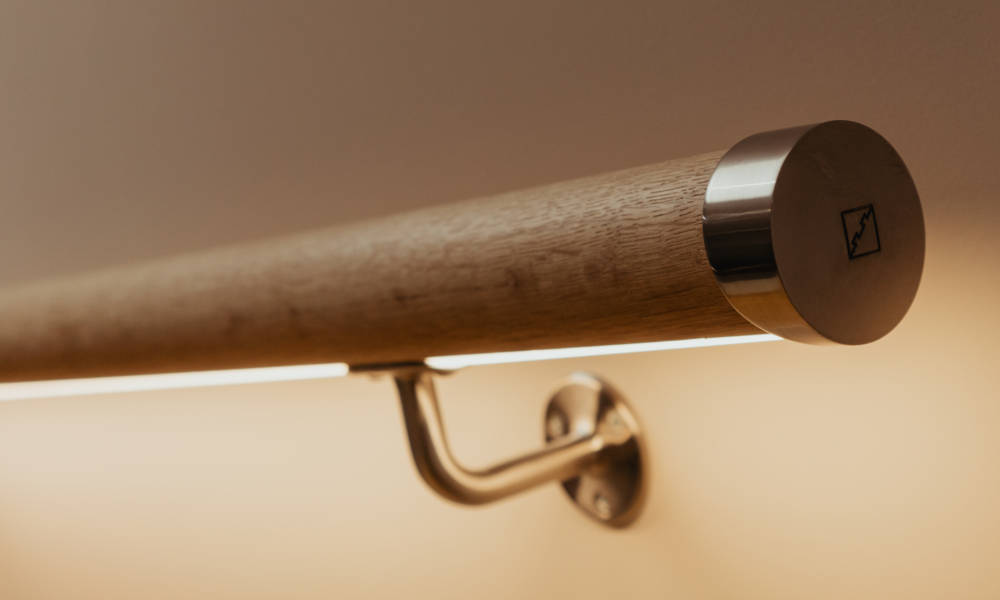
A popular option is to treat your oak handrails to a matt black finish, which looks incredibly stylish on any staircase, whether in a newer style home or an older, traditional build.
Another consideration for internal staircases is the end caps which are available in brass, copper or matt black, each one the perfect accompaniment to your oak handrail. Whichever you choose, you can keep these in sync with your brackets by matching the material. Alternatively, you may prefer to keep the handrail ends completely bare for a more minimalist look.
Enhance your oak handrail with LED lighting
Want to add that extra wow factor to your handrails? Integrating LED lighting into your handrails is sure to make them a talking point for guests. Aesthetically, you can achieve a genuine uplift by utilising LED, but it also serves a safety purpose, lighting the way clearly at floor/step level.

The lighting itself comes in different shades of white, giving you the option of a cooler, brighter appearance or one that’s more warm and natural. Either way, you’re guaranteed a stunning finish to your oak handrails when combined with LED lighting.
Oak handrail alternatives
These days, you’ll find hundreds of handrail options on the market, and many of them are made from materials other than wood. So if oak isn’t your thing, why not opt for a metallic handrail?

You’ll find plenty of stainless steel options available, also in different finishes to suit the environment and intended use. Outside, you may prefer to have a powder-coated finish for additional durability to your walkway handrails. Internally, a powder-coated rail will bring an innovative look and feel to your staircase or walls.
Let’s talk handrails
When it comes to stainless steel handrails, you can trust the experts at LED Handrails. Our products are manufactured to the highest quality, installed to British Standards and always adhere to building regulations as appropriate.
Contact our team today to discuss your handrail project.

